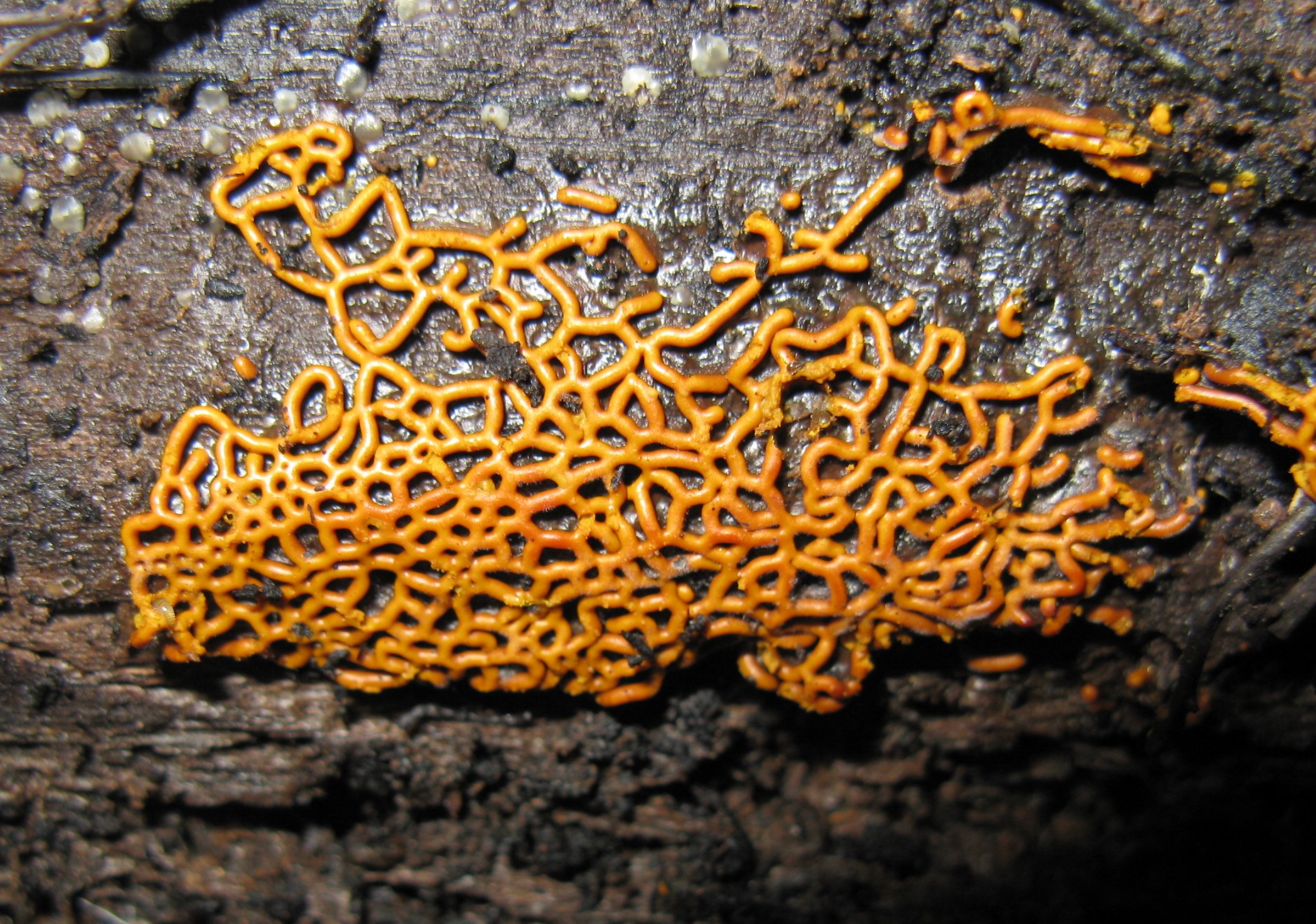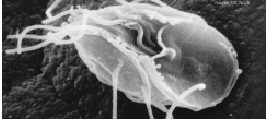|
Trichiida
Trichiales ( synonymous with Trichiida) is an order of slime moulds Slime mold or slime mould is an informal name given to several kinds of unrelated eukaryotic organisms with a life cycle that includes a free-living single-celled stage and the formation of spores. Spores are often produced in macroscopic mu ... in the phylum Amoebozoa. Trichiales is one of five orders in the group Myxomycetes (also called Myxogastria), or the true plasmodial slime molds. It is also currently categorized under the superorder Lucisporidia with its sister group, Liceales. The order was first described by Thomas MacBride in 1922, and has retained the same name and status as a defined order in present phylogeny. In the plasmodium form, members of Trichiales lack a columella but have a well-developed capillitium for spore dispersal. The shape and details of the capillitium are used to define families within the order. Spores are brightly coloured, ranging from clear, white and yellow to pink a ... [...More Info...] [...Related Items...] OR: [Wikipedia] [Google] [Baidu] |
Hemitrichia
''Hemitrichia'' is a genus of slime molds, of the family Trichiidae, found within the order Trichiida. It was first described by Josef Rostafinksi in 1873 and remains a well-defined genus of the slime molds. ''Hemitrichia'' species exhibit either plasmodiocarp or sporangium fruiting bodies, both of which are well-known and recognizable slime molds seen on multiple continents. The genus includes ''Hemtrichia serpula'', known as the pretzel slime mold, an iconic and widespread species that has been used to examine speciation in slime molds. Etymology ''Hemi'' comes directly from the Greek prefix hemi, meaning “half”. ''Trichia'' is combination of the Greek trichios, which refers to hair or hair-like structure and –ia, referring to a condition, leading to –''trichia'' being the condition of having hair. ''Hemitrichia'' therefore refers to the condition of partially having hair. Josef Rostafinkski described ''Hemitrichia'' in the family Trichiaceae, along with another genera ... [...More Info...] [...Related Items...] OR: [Wikipedia] [Google] [Baidu] |
Prototrichia
''Prototrichia metallica'' is a slime mould species from the order Trichiida and the only species from the genus ''Prototrichia''. It is mainly distributed on mountains. Characteristics ''Prototrichia metallica'' is a very variable species. The plasmodium is white. The fruit bodies are grouped densely. They are orange brown to dull brown, occasionally pink, short stemmed or are lying on a heavily regenerated edge, rarely plasmodiokarp sporokarps with a diameter from 0.5 to 2.2 mm. The membranous peridium is transparently thin and shinily iridescent-coloured. Its surface is composed of a coarse mesh arrangement of wrinkled lines, along which it later divides into pieces. The capillitium is often irregular, usually due to the presence of several yellow-brown, translucent spirally banded strands, which divide towards the outer end. The branches are often intertwined spirals, which sometimes form a network. Many of the outer ends are fused with the upper part of the peridiu ... [...More Info...] [...Related Items...] OR: [Wikipedia] [Google] [Baidu] |
Arcyriaceae
Trichiales (synonymous with Trichiida) is an order of slime moulds in the phylum Amoebozoa. Trichiales is one of five orders in the group Myxomycetes (also called Myxogastria), or the true plasmodial slime molds. It is also currently categorized under the superorder Lucisporidia with its sister group, Liceales. The order was first described by Thomas MacBride in 1922, and has retained the same name and status as a defined order in present phylogeny. In the plasmodium form, members of Trichiales lack a columella but have a well-developed capillitium for spore dispersal. The shape and details of the capillitium are used to define families within the order. Spores are brightly coloured, ranging from clear, white and yellow to pink and red-brown tones. The order currently has 4 families, 14 genera and 174 species. Recent molecular research has shown that while Trichiales probably represents a true taxonomic group, its sister group Liceales is likely paraphyletic, and it has been sugge ... [...More Info...] [...Related Items...] OR: [Wikipedia] [Google] [Baidu] |
Dianemataceae
Trichiales ( synonymous with Trichiida) is an order of slime moulds in the phylum Amoebozoa. Trichiales is one of five orders in the group Myxomycetes (also called Myxogastria), or the true plasmodial slime molds. It is also currently categorized under the superorder Lucisporidia with its sister group, Liceales. The order was first described by Thomas MacBride in 1922, and has retained the same name and status as a defined order in present phylogeny. In the plasmodium form, members of Trichiales lack a columella but have a well-developed capillitium for spore dispersal. The shape and details of the capillitium are used to define families within the order. Spores are brightly coloured, ranging from clear, white and yellow to pink and red-brown tones. The order currently has 4 families, 14 genera and 174 species. Recent molecular research has shown that while Trichiales probably represents a true taxonomic group, its sister group Liceales is likely paraphyletic, and it has been sug ... [...More Info...] [...Related Items...] OR: [Wikipedia] [Google] [Baidu] |
Trichiaceae
Trichiales ( synonymous with Trichiida) is an order of slime moulds in the phylum Amoebozoa. Trichiales is one of five orders in the group Myxomycetes (also called Myxogastria), or the true plasmodial slime molds. It is also currently categorized under the superorder Lucisporidia with its sister group, Liceales. The order was first described by Thomas MacBride in 1922, and has retained the same name and status as a defined order in present phylogeny. In the plasmodium form, members of Trichiales lack a columella but have a well-developed capillitium for spore dispersal. The shape and details of the capillitium are used to define families within the order. Spores are brightly coloured, ranging from clear, white and yellow to pink and red-brown tones. The order currently has 4 families, 14 genera and 174 species. Recent molecular research has shown that while Trichiales probably represents a true taxonomic group, its sister group Liceales is likely paraphyletic, and it has been sug ... [...More Info...] [...Related Items...] OR: [Wikipedia] [Google] [Baidu] |
Trichiidae
Trichiales ( synonymous with Trichiida) is an order of slime moulds in the phylum Amoebozoa. Trichiales is one of five orders in the group Myxomycetes (also called Myxogastria), or the true plasmodial slime molds. It is also currently categorized under the superorder Lucisporidia with its sister group, Liceales. The order was first described by Thomas MacBride in 1922, and has retained the same name and status as a defined order in present phylogeny. In the plasmodium form, members of Trichiales lack a columella but have a well-developed capillitium for spore dispersal. The shape and details of the capillitium are used to define families within the order. Spores are brightly coloured, ranging from clear, white and yellow to pink and red-brown tones. The order currently has 4 families, 14 genera and 174 species. Recent molecular research has shown that while Trichiales probably represents a true taxonomic group, its sister group Liceales is likely paraphyletic, and it has been sug ... [...More Info...] [...Related Items...] OR: [Wikipedia] [Google] [Baidu] |
Dianemidae
Trichiales (synonymous with Trichiida) is an order of slime moulds in the phylum Amoebozoa. Trichiales is one of five orders in the group Myxomycetes (also called Myxogastria), or the true plasmodial slime molds. It is also currently categorized under the superorder Lucisporidia with its sister group, Liceales. The order was first described by Thomas MacBride in 1922, and has retained the same name and status as a defined order in present phylogeny. In the plasmodium form, members of Trichiales lack a columella but have a well-developed capillitium for spore dispersal. The shape and details of the capillitium are used to define families within the order. Spores are brightly coloured, ranging from clear, white and yellow to pink and red-brown tones. The order currently has 4 families, 14 genera and 174 species. Recent molecular research has shown that while Trichiales probably represents a true taxonomic group, its sister group Liceales is likely paraphyletic, and it has been sugge ... [...More Info...] [...Related Items...] OR: [Wikipedia] [Google] [Baidu] |
Trichia
''Trichia'' is a genus of slime molds in the family Trichiidae Trichiales ( synonymous with Trichiida) is an order of slime moulds in the phylum Amoebozoa. Trichiales is one of five orders in the group Myxomycetes (also called Myxogastria), or the true plasmodial slime molds. It is also currently categoriz .... , there are 34 species in the genus. Species *'' Trichia affinis'' *'' Trichia agaves'' *'' Trichia alpina'' *'' Trichia antartica'' *'' Trichia botrytis'' *'' Trichia brevicapillata'' *'' Trichia brimsiorum'' *'' Trichia brunnea'' *'' Trichia conglobata'' *'' Trichia contorta'' *'' Trichia crateriformis'' *'' Trichia crenulata'' *'' Trichia decipiens'' *'' Trichia elaterensis'' *'' Trichia erecta'' *'' Trichia favoginea'' *'' Trichia fimicola'' *'' Trichia flavicoma'' *'' Trichia heteroelaterum'' *'' Trichia huizhongii'' *'' Trichia lutescens'' *'' Trichia macbridei'' *'' Trichia microspora'' *'' Trichia mirabilis'' *'' Trichia munda'' *'' Trichia nodosa'' *'' Tric ... [...More Info...] [...Related Items...] OR: [Wikipedia] [Google] [Baidu] |
Arcyria
''Arcyria'' is a genus of Amoebozoa in the family Arcyriaceae.Cooke, M.C. (1877) Contributions to Mycologica Britannica. The Myxomycetes of Great Britain: 69 (1877)Mycobank: Acyriaceae Accessed 16 June 2019. It includes the species '''' . Species *'' Arcyria affinis'' *'' Arcyria afroalpina'' *'' Arcyria aggregata'' * ...[...More Info...] [...Related Items...] OR: [Wikipedia] [Google] [Baidu] |
Amoebozoa
Amoebozoa is a major taxonomic group containing about 2,400 described species of amoeboid protists, often possessing blunt, fingerlike, lobose pseudopods and tubular mitochondrial cristae. In traditional and currently no longer supported classification schemes, Amoebozoa is ranked as a phylum within either the kingdom Protista or the kingdom Protozoa. In the classification favored by the International Society of Protistologists, it is retained as an unranked " supergroup" within Eukaryota. Molecular genetic analysis supports Amoebozoa as a monophyletic clade. Modern studies of eukaryotic phylogenetic trees identify it as the sister group to Opisthokonta, another major clade which contains both fungi and animals as well as several other clades comprising some 300 species of unicellular eukaryotes. Amoebozoa and Opisthokonta are sometimes grouped together in a high-level taxon, variously named Unikonta, Amorphea or Opimoda. Amoebozoa includes many of the best-known ... [...More Info...] [...Related Items...] OR: [Wikipedia] [Google] [Baidu] |
Amoebozoa Orders
Amoebozoa is a major taxonomic group containing about 2,400 described species of amoeboid protists, often possessing blunt, fingerlike, lobose pseudopods and tubular mitochondrial cristae. In traditional and currently no longer supported classification schemes, Amoebozoa is ranked as a phylum within either the kingdom Protista or the kingdom Protozoa. In the classification favored by the International Society of Protistologists, it is retained as an unranked " supergroup" within Eukaryota. Molecular genetic analysis supports Amoebozoa as a monophyletic clade. Modern studies of eukaryotic phylogenetic trees identify it as the sister group to Opisthokonta, another major clade which contains both fungi and animals as well as several other clades comprising some 300 species of unicellular eukaryotes. Amoebozoa and Opisthokonta are sometimes grouped together in a high-level taxon, variously named Unikonta, Amorphea or Opimoda. Amoebozoa includes many of the best-known amoeboid org ... [...More Info...] [...Related Items...] OR: [Wikipedia] [Google] [Baidu] |


